

Table of contents
- Most common causes + first aid
- Feeding damage or other damage caused by animals
- frost damage
- gum flow
- Mechanical injuries
- fruit tree cancer
- bark burn
- bark scab
- cutting reaction
- sunburn
- growth stress
- white or brown rot
- Not clearly identifiable bark damage
- wound disinfection
- Make nettle manure
- wound closure?
- Other conservation measures
Burst tree bark is worrying, but can heal without any problems like a scratch on the skin; similar to this one best in air. However, in the case of deep wounds down to the cambium, the growth layer under the bark, the tree needs proper wound care and maybe even a pressure bandage so that the injury heals without consequences and does not become a gateway for infections becomes:
Most common causes + first aid
If you notice an injury to the bark on one of your trees, the first thing to do is to help the poor tree as quickly as possible. The most common causes of bark damage, including the immediate measures to be taken, are briefly described below, sorted from A to Z for a better overview:
Feeding damage or other damage caused by animals
infested trees
Especially fond of young trees whose bark is eaten; if animals are interested in the bark for other reasons, the age of the tree does not matter
frequency
Depends, if nearby game can gain access to tasty young trees, the bark will likely be damaged. The danger of browsing by wild animals is usually known, surprises threaten in city gardens that are visited by new, wild city dwellers.
symptoms
When red deer nibbles on the bark of a newly planted tree on an orchard or when wild boars visit the gardens of private homes near the forest, the tracks are usually unmistakable
First aid
Wound disinfection with stinging nettle manure, pressure bandage or natural wound closure depending on the severity of the damage, support the tree with plant strengtheners
Tip:
If you see one of the small animals whose territory your garden is in running away/flying away with bits of bark in its mouth or beak, they certainly haven't been nibbling on the tree bark. Where bark is easily plucked or scooped up from the ground, there may be more extensive damage that needs to be investigated and treated; the trees should be checked.
frost damage
infested trees
Especially (young) ornamental trees from the south that are not really hardy at the location.
frequency
Quite common for trees and shrubs from the mass trade (insufficient labeling affects horticulture beginners)
symptoms
After a frosty winter, the tree bark bursts in spring
First aid
Wound disinfection with stinging nettle manure, preventive fungal control in the event of high fungal pressure in the environment, natural wound closure, (fungicidal) plant strengtheners, increase winter protection next autumn, maybe Apply white paint to the sunny side
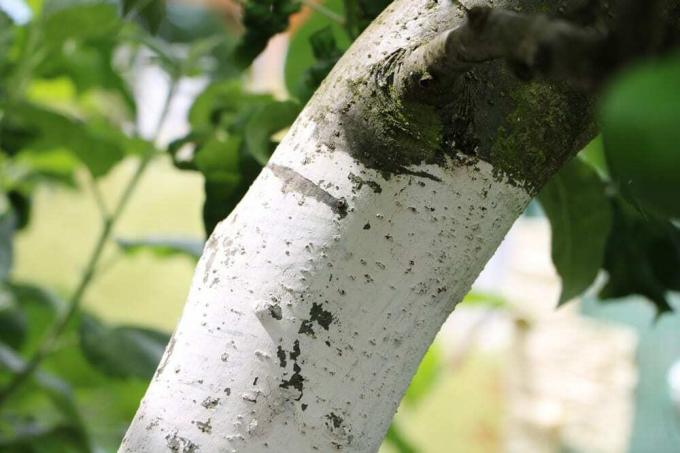
gum flow
infested trees
Stone fruit such as apricots, cherries, cherry laurel, cherry plum, almond, peach, plum, sloe, bird cherry, ornamental cherry, plum
frequency
Common only when the tree has been weakened by extremely wet weather, fungal attack, care errors
symptoms
Bark bursts open, tree resin leaks out of the opening
First aid
Reduce moisture pressure around and in the tree (pruning) as much as possible, treat fungal infestation, Eliminate care errors if possible, tree with nettle manure or other suitable means strengthen. Do not cut out the wound as this will stimulate the gum flow even more
Mechanical injuries
infested trees
All garden shrubs (which are pruned)
frequency
Frequently, since this also includes cutting measures with blunt/unsuitable tools
symptoms
Frayed, cracked wound edges (instead of smooth cut edges)
First aid
Cut with a sharp tool + treat the wound. Mechanical injuries e.g. B. Only use construction vehicles to take care of minor damage yourself, otherwise have it assessed
fruit tree cancer
infested trees
Maple (maple stem canker), apple tree, pear tree, birch, beech, oak, ash, alder, currant, linden, poplar, holly, elm, walnut, willow, hawthorn.
frequency
Economically significant only in commercial orchards, rarely in home gardens (then mostly on old trees)
symptoms
(Starts of) growths under the bark, traces of fungus when the bark is lifted (white spore coating, orange "pinheads")

First aid
Immediately cut out the affected area down to the healthy wood, disinfect, treat with (biological) fungicides. Check the stability of old trees in a weakened state (have them checked)
bark burn
infested trees
Stone fruit, especially plums and cherries
frequency
Infects only in (permanently) wet weather at the time of flowering/fruit ripening/leaves falling in autumn
symptoms
Grooved, deep-seated black-red injuries that rupture in April/May, then mostly gum discharge (see above), possibly Leaf infection (shotgun-like symptoms, glassy translucent holes with a yellowish border)
First aid
Cut back infested trunk sections into healthy wood, strengthen the tree and its natural environment (frequently recommended plant protection products containing copper are not permitted in home gardens and allotments)
bark scab
infested trees
rose family, v. a. apple trees
frequency
Hopefully rare, since scab in the trunk is usually the late stage of a scab infestation that has not been treated for a long time
symptoms
Scab symptoms in the tree, cracked sores in the bark
First aid
Hardly possible, general scab control as described in "Apple scab - Successfully combating scab with these agents" is required
cutting reaction
infested trees
In principle all, with (too radical) pruning (at the wrong time) unplanned growth processes can be stimulated in almost every tree; practically react v. a. Fruit and ornamental trees sensitive to radical pruning, cherries are considered e.g. B. as not very well compatible with cutting
symptoms
Tree continues to grow seemingly normally, but produces excessive "panic" tissue that bursts the bark or dies in sections well into the cambium
First aid
Curb excessive growth by cutting, remove stress shoots, air and dry in the event of large-scale detachment of the bark apply a moisture-permeable pressure bandage (made of natural materials such as sisal, twine, raffia, must be loosened regularly become)
sunburn
infested trees
All in sunny locations
frequency
not assessable
symptoms
The south-facing side of the trunk gets much warmer than the rest of the trunk, even in winter, and the tension that occurs causes the bark to burst open
First aid
Disinfect and treat the wound, protect the sunny side from overheating with white paint in autumn
growth stress
infested trees
All planted in wrong soil or improperly tended; e.g. B. Cherry trees tend to burst if planted in soil that is too light
symptoms
Initially smaller, vertical cracks in the bark

First aid
Set light soils to be more storage-capable (loam, mature compost), avoid over-fertilization with artificial fertilizers (if slow-acting organic fertilizers are used), possibly Flush out road salt damage or replace the floor. "Pamper" the tree with plant strengthening agents, the bark often hardens again by itself and the damage grows out without consequences.
white or brown rot
infested trees
old dying trees; Younger trees with trunk injuries that were not treated properly (long open wounds, dead wood on the trunk)
symptoms
There are around 30 deadwood-degrading fungi, a good 20 of which cause white rot (wood appears fibrous and covered with a white-grey veil), the Remainder of brown rot/soft rot (wood turns dark brown to black, breaks up into "cubes"), some attack living ones as wound parasites Plant. All of these fungi cause what appears to be "cracked or chipped bark" on the trunk.
First aid
Cut out smaller wounds down to the healthy wood, disinfect, treat with natural fungicides. In the case of larger wounds, consult a professional arborist, also for stability
Not clearly identifiable bark damage
Often the bark damage cannot be traced back to a damage pattern. There are a wide variety of bacteria and viruses that cause bark damage with an indeterminate probability. Determining the exact cause is usually only possible with considerable effort, laboratory tests, etc. possible. Whether and when this is necessary is a matter of assessment, although you may ask your “healthy gut feeling”:
If the damage shows any strange appearance, color, evidence, a nasty disease could be behind it. The sooty bark disease z. B., which first stains the wood green or blue and then forms thick black fungal growths. It can cause the tree to die and must be examined by a tree specialist because it poses a health risk to people. Occurs rather seldom and only with the maple The sample operating instructions to be downloaded "Pathogen of the sooty bark disease of the maple: Cryptostoma corticale" is therefore Interesting because it illustrates well why, when in doubt, it is healthier for both the tree AND the owner to leave the work to be done by a professional (and why his Earned money).
If the bark flakes off over a large area, professional assessment is often unavoidable. The hobby gardener usually cannot and must not judge when a lack of stability makes an emergency felling necessary. But before that, common sense can be used here as well: Whether a tree looks vital or not can also be determined inexperienced gardener when he carefully examines the tree (if in doubt, take action because you are liable if someone damage occurs). A call to the local environmental/plant protection office often brings help, tips for checking stability and perhaps also the cause of the damage, e.g. B. if certain damage/pathogens are occurring in the region in large numbers.
If damage to the bark that does not appear to be alarming is found on the otherwise healthy tree and the tree continues to grow normally, you can treat the wound without investigating the cause take precautions:
wound disinfection
In our part of the world, an underestimated, often unkindly cursed ("..., pikt hell!") wonder herb grows, which is also used for wound disinfection can: The stinging nettle, carrier of numerous highly effective ingredients such as silicic acid, iron, manganese, potassium, acetylcholine, caffeoylquinic acids, flavonoids, Chlorophyll, sterols, histamine, serotonin, formic acid, which can do much more than "prick people's calves", namely in horticulture as insecticides and fungicides serve.
Make nettle manure

- Treat bark injury in warm, dry weather
- Cut out the wound so that the cut edges are smooth
- Rinse or spray out several times with nettle liquid manure
- If moisture remains, trim accordingly
- Pat the wound as dry as possible with absorbent, lint-free (kitchen) paper or cloth
- How quickly the wound dries determines whether flying fungi can settle
- The ingredients of nettle manure also strengthen the tree
- And they nourish (fertilize) him, e.g. B. with the minerals it contains
wound closure?
Experts have been arguing for years as to whether wound closure helps the cambium (growth and supply tissue under the bark) or not the situation of the plant is rather aggravated because the wound is closed more or less airtight, including those inside Mushrooms.
With the numerous commercially available wound closure pastes, ointments and waxes, you usually do not find out exactly how dense they are make a wound, whether the artificial wound closure cracks when it dries and how well the ingredients really do affect the cambium do.
Most professionals, including public tree inspectors, are in favor of letting the tree heal itself; they only cut the wound well free so that the air can circulate well and the wound is dried as quickly as possible by the sun and air. After all, fungal spores are in the air everywhere, they will have landed on the wound long ago anyway, "applying when wet" tends to favor the fungi.
In the case of those who control our street and avenue trees and, if necessary, However, treating tree professionals can be assumed to be pruning the tree at the right time and in the right way. What is often not the case in private gardens, on numerous older pages z. B. the winter pruning for fruit trees is still propagated, which experts today see as a relic from the past Keeping time (arose because farmers only had time to trim their trees in winter trimming).
To make a reasoned decision for or against the use of a particular wound closure product in a particular case can, you would have to get closer to the discussion in the professional world and the ingredients of the commercially available wound closure agents occupy. If you need to make the decision about the application before you have done so, a pragmatic middle way could be e.g. B. look like this:
For minor wounds, trust the knowledge of the public tree inspectors and leave the wounds open after careful pruning/pruning. However, make sure you inquire about the latest state of knowledge in relation to cutting times (summer cutting at the time, too which the respective tree species can close the wound most quickly) and only work with well-kept and sharp tools Tool. For larger wounds, try to get more information about whether wound closure is appropriate in the individual case is or isn't (perhaps you can ask a public arborist who's just around the corner of the road is working).

Tip:
The alternative to commercially available wound closure paste is the natural wound closure: clay coating that allows air and moisture to pass through or lime paint, which depending on the occasion and situation with cow dung, horsetail or nettle broth, rock flour, algae lime, wood ash and a. can be offset to achieve an even better effect. You can find numerous recipes and instructions for making tree paints, e.g. B. on www.gründienst.de/reload.html? obstbaumanstrich.html, where you can also find out a lot about other advantages of trunk maintenance.
Other conservation measures
Wound care is an important first measure, but the tree can obviously provide an overall boost tolerated (if the damage is not exclusively due to external events such as accidental sawing goes back). Check the nutrient supply, the water balance of the tree, the site conditions and improve everything that can be improved (without huge effort like transplanting).
Promote the natural balance in your garden so that there are enough predators to limit pest infestation. Give back to the tree some of the topsoil that would normally form from the fallen leaves just below it, but is left to rot on the compost for clutter or fungus prevention. Various plants can be made into broths and potted around the tree; excellent plant strengtheners, fungus and disease defenses that also fertilize and are very difficult to overdose compared to synthetic fertilizers.
 garden editorial
garden editorial I write about everything that interests me in my garden.
Learn more about plant diseases
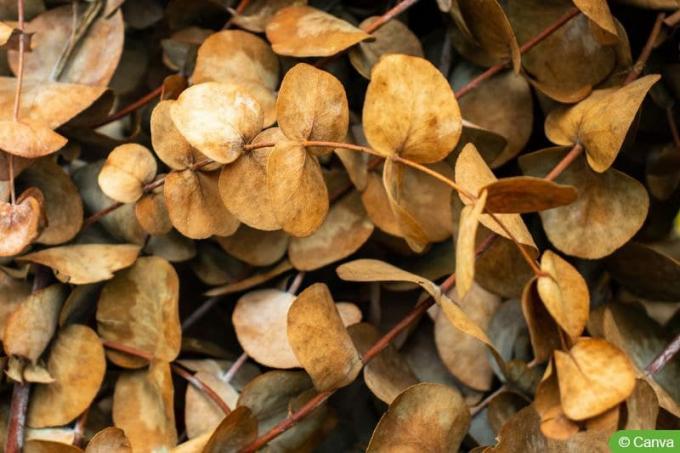
Eucalyptus gets brown/yellow leaves
The eucalyptus is becoming more and more of a trend plant. With its blue-green leaves, the eucalyptus sets beautiful accents. Occasionally, however, foliage discoloration may occur. Everything about the causes and remedial measures below.

Small white dots on leaves: what to do?
When white dots appear on the leaves of crops, take a closer look as they can indicate problems. This text explains what causes can be responsible for this and what you can do about the stains.
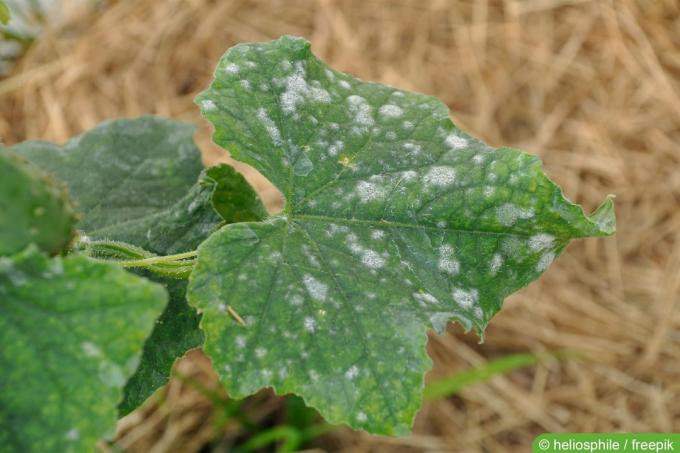
Powdery mildew on cucumbers: how to get rid of it
The powdery mildew often stops by the cucumber bed and quickly conquers the entire plant. That is why every gardener must recognize it early and fight it properly. This is the only way to save the cucumber harvest.

Fighting frizz | 9 home remedies
Peaches from your own garden taste wonderful. More and more hobby gardeners are trying to grow the tasty fruits themselves. The joy is clouded by the appearance of leaf curl in spring. What is this disease? How can you prevent or fight them?
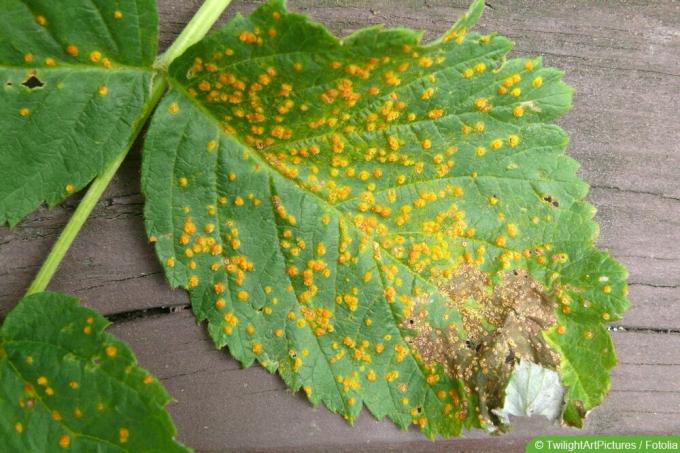
Fighting rust on plants biologically | 5 home remedies
Leaf or plant rust is caused by fungi and can affect ornamental plants as well as crops. Most species of fungi are specialized to a single host or host family and are transmitted by wind. The infestation rate increases significantly with moisture.
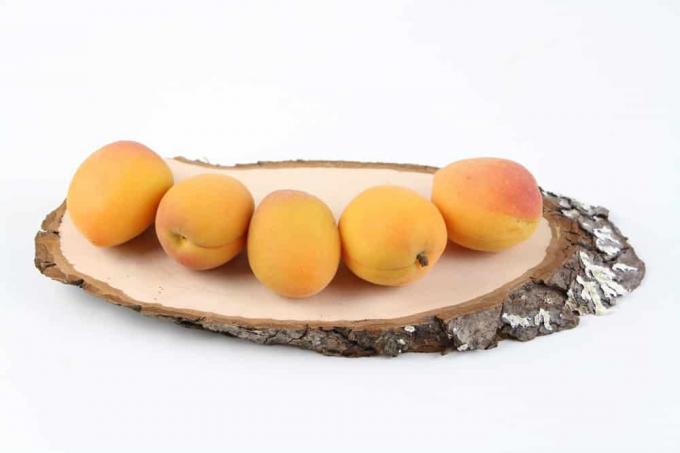
10 typical diseases of the apricot tree and apricot tree
Apricots are one of the most popular fruits in Germany. It becomes difficult to care for an apricot tree in such a way that it is not attacked by a disease. Apricots are known for their susceptibility to diseases and it is therefore important to be able to distinguish between the individual diseases.

